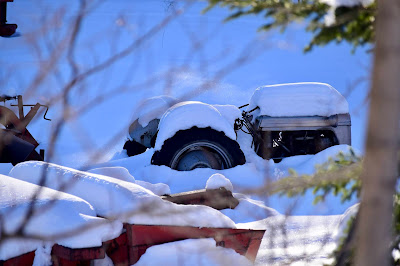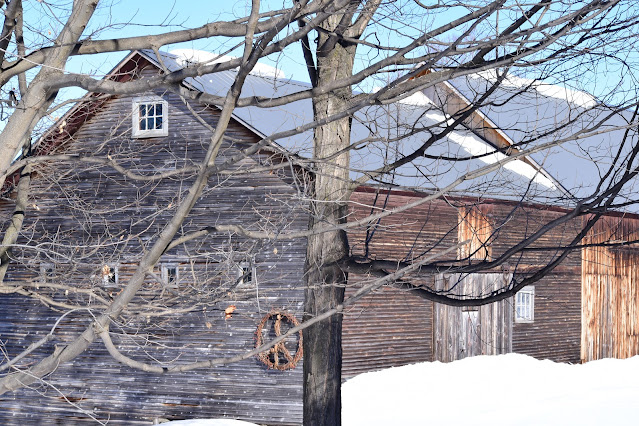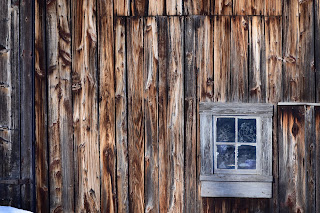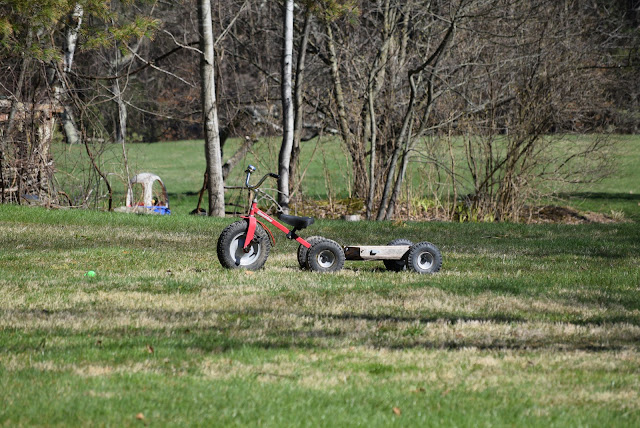When is a road not a road in name? When it is a trace as in Browns Trace in Jericho. Trace is a synonym for trail. As such, in this our Roads of Community Living, Series number 24, we blazed our way along Browns Trace.
Along the way, we viewed gorgeous fall foliage, tasted some real fine Vermont Maple Syrup from Birch Hill Sugarworks, went face to face with a horse with no name, looked out at ocean blue mountains stretching out beyond Birch Hill farm, thought of the love of community expressed in a field of heart-art.
During the winter, we scratched our heads at seeing a supersized snowball all aglow as though on fire, resting atop a chimney. We viewed weathered barns, children's slides, idled tractors, storied books, and tracks - all against or upon snow. Art of creation to art of work cradled in necessity - both awed us.
In each season as we walked Browns Trace, we looked down, we looked across, we looked nearby and afar, we even looked up at pine cones in a heavy mast year, and weathervanes in all weather. Stones positioned perfectly together - stone walls with stories to tell, granite holding up a mailbox, chairs rested in spots that looked like good sitting sites.
From babbling brooks to near-silent rustling leaves and blowing snow, from clean bright yellow of school buses, to fire engine red of fire trucks and barns, the diverse colors pleased our taste pallet as much as did the maple syrup.
The sights of farmers' fields, horses swishing their tails, and the many "Black Lives Matter" signs, all spoke of the community along Browns Trace in Jericho, Vermont.
View below some of the sights we enjoyed. Then go yourself to see, smell, hear, and feel the community of Jericho along Browns Trace.
Jericho Vermont Images of Community
Emailed Comments
Vt horses all look well-cared for! But not so much their tractors? On the farm where I grew up we always at least put a canvas over our tractors or parked them under a tarp, to keep them out-of-inclement weather. On our farm, I think tractors were treated with TLC than even our Model T car for it was in a way, one of the primary avenues of lifeblood for our very survival.
I noticed the Ferguson tractor. Our first tractor was a Ford-Ferguson. I thought that was the earliest model made by whoever Ferguson was but now I'm wondering which came first, not the chicken or egg, but the Ferguson or Ford-Ferguson.In fact, who was Ferguson? I don't think there are too many tractors with hybrid names these days.
When I was growing up the "Cadillac" of all tractors at the time, when it came on the
market, was the John Deere. Far too expensive for my Dad and Uncle to ever consider owning one, especially a new one! Running on tracks? How could that be? Well, I think it was a transformation from military use as tanks to commercial use as farm tractors.
At that time the fact that tractors had a "power takeoff" which was an invention that
allowed the tractor power to be transferred to many other devices, thus making
tractors adaptable to so many uses, other than just pulling a wagon, like
with oxen or horses. We take power take-offs for granted these days! No horse could substitute for that.
I don't know if my uncle appreciated that or not. The downside was that many a farmer or farmer's child either lost their lives or were maimed because they were caught in the rapid turning of the pt, until later tractor models had mandatory (by law) shields put over them. Farming was and still is!-a very dangerous occupation, some types more than others of course!
Another big advantage of tractors was that they could not kick or bite you but woe betide the young man who tried to shift gears of a tractor while just starting down a steep hill while hooked up to a heavy load! You could not command it "whoa" to prevent a real possible disaster (I know, I made that mistake once. Fortunately, I got another chance to do it right). But the down-size of tractors however was that they could get stuck in the snow far more easily than horses.
My uncle, a rather irascible individual, was very skeptical of my father negotiating with him and they finally purchased our very first and "brand new" tractor!! My uncle was very suspicious that they would make our landless productive than that which resulted from having horses doing the "pull" work. He felt that our tractor would make the ground too compact! Remember that plowing of land was in a way a method of making the soil less compact and tractors were much better at that than horses! Imagine one man plowing with one horse pulling a one-horse plow and keeping that all-important requirement-"the row straight!!".
Darn good thing he wasn't aware of the behemoths that many farmers use these days. It would have really challenged his vocabulary of expletives!, I'm sure!
Stone boats were used to make those stone walls! Wonder how many people know
what they were?
I was intrigued by that one set of tracks across that field, seen from Brown's trace.
I wondered if it might be Erethizon dorsatum?
D.M.
































































































No comments:
Post a Comment